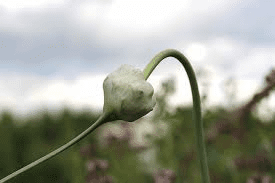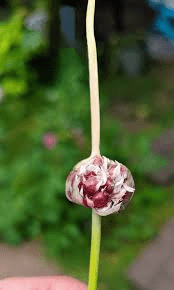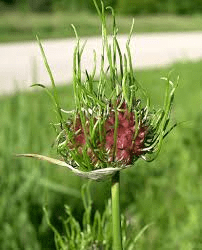The garlic pedicel is a slender stalk, typically ranging from a few millimeters to a centimeter in length. It arises from the main axis of the scape, the rachis, and acts as an individual flower’s lifeline. Imagine a miniature bridge – the pedicel connects the delicate flower bud to the rachis, providing structural support and a channel for the vital exchange of water, nutrients, and photosynthetic products.
Garlic, like its close relatives onions and chives, produces an inflorescence known as an umbel. This umbrella-shaped cluster groups numerous tiny flowers on individual pedicels, radiating outwards from the rachis. The pedicel’s orientation within the umbel is meticulously arranged.
They typically grow at an angle, ensuring each flower receives optimal sunlight for successful pollination. Interestingly, some studies suggest the pedicel might possess a degree of movement in certain Allium species.
This ability, known as thigmonasty, allows the pedicel to respond to touch stimuli, potentially reorienting the flower bud for better pollination if disturbed by wind or insects.
Beyond its structural role, the garlic pedicel also plays a part in the plant’s defense mechanisms. The presence of hair-like structures called trichomes on the pedicel has been observed in some Allium species. These trichomes can be secretory, releasing deterrents or acting as physical barriers against herbivores seeking to devour the developing flowers or seeds.
The pedicel’s anatomy reveals a fascinating interplay of different tissues. The outer layer, the epidermis, is typically composed of single-celled, tightly packed cells that form a protective barrier. The inner core is occupied by parenchyma cells, responsible for storing water and nutrients. Vascular bundles, the plant’s circulatory system, weave through the core, transporting water, minerals, and sugars to and from the flower.
The pedicel’s development is tightly linked to the overall flower bud formation. As the flower bud initiates and grows, the pedicel elongates alongside it, ensuring the bud remains positioned for optimal sunlight capture and eventual pollination. Once the flower opens and pollination occurs, the pedicel plays a crucial role in seed development. It continues to transport nutrients to the developing ovary, which matures into a fruit or seed capsule in the case of garlic.
The scientific study of garlic pedicels, though not as prominent as research on the cloves themselves, contributes to our understanding of plant architecture and development. Examining the pedicel’s structure, function, and response to stimuli provides valuable insights into the intricate mechanisms that govern a plant’s reproductive success.
This knowledge can not only inform breeding programs for improved garlic varieties but also shed light on the evolutionary adaptations that have allowed garlic and its relatives to thrive across diverse environments.
In conclusion, the garlic pedicel, often overlooked, emerges as a vital yet understated player in the garlic’s life cycle. From providing structural support and facilitating nutrient transport to potentially contributing to defense mechanisms, this tiny stalk plays a significant role in ensuring the plant’s reproductive success.
As research delves deeper, the garlic pedicel may continue to unveil its secrets, offering valuable knowledge for plant scientists and garlic enthusiasts alike.
Garlic (Allium sativum) is a culinary cornerstone, revered for its pungent flavor and ability to elevate countless dishes. But the focus often falls solely on the plump cloves, neglecting another valuable part of the plant: the garlic pedicels. These slender stalks, connecting individual flowers within the garlic scape (flowerhead), hold surprising potential for various economic and practical uses.
The Economic Importance and Uses of Garlic Pedicels

1. A Culinary Delight: Far from mere waste, garlic pedicels are surprisingly tender and flavorful. Finely chopped or sliced, they add a subtle garlicky nuance to stir-fries, soups, stews, and pickles.
2. Enhanced Animal Feed: Dehydrated or ensiled garlic pedicels can be incorporated into livestock feed as a nutritious and flavorful supplement. This not only adds variety to animal diets but also boasts potential health benefits due to the presence of bioactive compounds in garlic.
3. Sustainable Dyes: Nature’s bounty extends to color! The pigments within garlic pedicels can be extracted and used as natural dyes for textiles. This creates a range of earthy tones, perfect for eco-conscious clothing and fabric production.
4. Biofuel Potential: Garlic pedicels, alongside other agricultural byproducts, can be fermented to produce bioethanol, a renewable fuel source. This helps reduce dependence on fossil fuels and contributes to a more sustainable energy future.
5. Vermicomposting Powerhouse: Chopped garlic pedicels become valuable additions to vermicomposting bins. They enhance the nutrient content for worms, leading to richer, more effective compost that nourishes plants and improves soil health.
6. Natural Mulch Magic: Shredded garlic pedicels serve a double purpose as mulch. They help retain moisture in the soil, suppressing weed growth. Additionally, as they decompose over time, they release valuable nutrients back into the soil, promoting plant health.
7. Medicinal Possibilities: While research is ongoing, studies suggest potential health benefits associated with garlic pedicels. Their antimicrobial and antioxidant properties might contribute to overall well-being.
8. Fiber Innovation: The cellulose fibers present in garlic pedicels hold promise for the future. With further processing, they might be suitable for use in biocomposite materials or even textiles, promoting sustainable and innovative product development.
9. Fungal Feast: Garlic pedicels can be given a new lease on life as a substrate for cultivating certain types of mushrooms. This provides farmers with an additional income stream and expands the variety of fungi available for consumption.
10. Food Preservation Potential: The antimicrobial properties of garlic pedicels might extend beyond human health. Research is exploring the possibility of harnessing these properties to create natural food preservatives or even antimicrobial packaging materials, extending the shelf life of food and reducing spoilage.
Read Also General Features of Ruminant Animals
The Products and By-products Derived from Garlic Pedicels

1. Dehydrated Pedicels: Dehydration extends the shelf life of garlic pedicels significantly. This allows for easier storage, transportation, and incorporation into various applications throughout the year.
2. Garlic Pedicel Flour: Grinding dehydrated garlic pedicels yields a versatile flour. This flour can be used as a thickener, flavoring agent, or nutritional supplement in food products, adding a subtle garlicky touch and a boost of nutrients.
3. Bioethanol Production: As mentioned earlier, fermentation of garlic pedicels can lead to the creation of bioethanol. This biofuel can be a viable alternative to fossil fuels, promoting cleaner energy practices.
4. Enriched Vermicompost: Garlic pedicels play a crucial role in enhancing the quality of vermicompost. The resulting compost becomes a valuable soil amendment, rich in nutrients and beneficial for plant growth.
5. Nutrient-Rich Mulch: Shredded garlic pedicels decompose over time, releasing nutrients back into the soil and improving its structure. This creates a healthy environment for plant roots to thrive.
6. Natural Dyes for Textiles: Extracting pigments from garlic pedicels provides a sustainable source of dye for the textile industry. This allows for the creation of eco-friendly clothing and fabrics with beautiful earthy tones.
7. Biocomposite Materials of the Future: The cellulose fibers within garlic pedicels might hold the key to developing innovative biocomposite materials. These materials have the potential to be used in various applications, from construction to household products.
8. Fungal Biomass Generation: Garlic pedicels can be used as a substrate for cultivating mushrooms. This not only creates a valuable source of income for
Read Also Feeding Materials for Ruminant Animals
Frequently Asked Questions (FAQ’s) About Garlic Pedicels

1. What are garlic pedicels?
Garlic pedicels are the small stalks that connect the flowers of the garlic plant to the main flowering stem. They are part of the plant’s reproductive structure.
2. Can you eat garlic pedicels?
While garlic pedicels are technically edible, they are often tough and fibrous, making them less desirable for culinary use compared to garlic bulbs or scapes.
3. What is the difference between garlic scapes and garlic pedicels?
Garlic scapes are the green, curly stalks that emerge from the garlic plant, while garlic pedicels are the smaller stalks that hold the individual flowers or bulbils.
4. How do garlic pedicels form?
Garlic pedicels form as part of the garlic plant’s flowering process. When the plant sends up a flowering stem, the pedicels hold the flowers or bulbils that eventually form at the top.
5. Are garlic pedicels used in traditional medicine?
Garlic pedicels are not commonly used in traditional medicine. Most of the health benefits associated with garlic come from the bulbs, which contain higher concentrations of beneficial compounds.
6. Can garlic pedicels be used for propagation?
Yes, garlic pedicels can bear bulbils, which are small, aerial bulbs that can be planted to grow new garlic plants. This is an alternative method of garlic propagation.
7. Do garlic pedicels affect the growth of garlic bulbs?
Yes, if the flowering stem and pedicels are allowed to mature, they can divert energy away from the bulb development. Removing the flowering stalk (including the pedicels) helps the plant focus on growing larger bulbs.
8. How are garlic pedicels harvested?
Garlic pedicels are not typically harvested separately. When removing the garlic scape (the flowering stem) to encourage bulb growth, the pedicels are removed along with it.
9. Can you use garlic pedicels in floral arrangements?
Garlic pedicels can be used in floral arrangements for their unique appearance, especially when in bloom. They add an interesting, natural element to arrangements.
10. Are there any commercial uses for garlic pedicels?
Garlic pedicels do not have significant commercial uses. Most commercial garlic production focuses on the bulbs, while the scapes may also be marketed as a culinary ingredient.
Read Also Low-Maintenance Plants for Beginners
